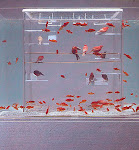 The Marvel Of Nature: Sofonisba Anguissola
The Marvel Of Nature: Sofonisba AnguissolaDuffy-Zeballos, Lisa. "Sofonisba Anguissola’s Self-portrait." Archives of Facial Plastic Surgery. 2007. American Medical Association. 1 Feb. 2009 .
It was interesting to find information on Sofonisba Anguissola on a site from the American Medical Association, but after I viewed the content I started to understand. Sofonisba Anguissola did primarily portraiture and self-portraits because of her status as a lady. She was restricted from selling her paintings; instead giving them away and receiving “gifts” in return. However, the American Medical Association a takes interest in her lack of anatomical knowledge. As a lady, she was never allowed to study the human body (i.e. nudes or cadavers) and painted solely on what she saw rather than an intimate knowledge of body. It may have been this deficiency that prevented her from being allowed to paint multi-person religious murals. This underlines her natural artistic abilities because she was at a disadvantage in many ways to her male peers.
It was interesting to find information on Sofonisba Anguissola on a site from the American Medical Association, but after I viewed the content I started to understand. Sofonisba Anguissola did primarily portraiture and self-portraits because of her status as a lady. She was restricted from selling her paintings; instead giving them away and receiving “gifts” in return. However, the American Medical Association a takes interest in her lack of anatomical knowledge. As a lady, she was never allowed to study the human body (i.e. nudes or cadavers) and painted solely on what she saw rather than an intimate knowledge of body. It may have been this deficiency that prevented her from being allowed to paint multi-person religious murals. This underlines her natural artistic abilities because she was at a disadvantage in many ways to her male peers.
Fulmer, Betsy. "Sofonisba Anguissola: Marvel of Nature." Henderson State University Academic Forum. 2006. 1 Feb. 2009 .
This essay contains a wonderful discussion of Sofonisba Anguissola’s life, status, and possible interpretations of some of her more famous paintings. Anguissola was the eldest daughter of a liberally-minded noble family during the Italian Renaissance. Her father, Amilcare, paid for the education of all six of his daughters as though they were sons; including the skills of reading, writing and art in a time when women were seen as possessions. All six daughters became artists, but Sofonisba was the most famous and the “first internationally recognized female artist.” Her mature style brought life to the then common “still” settings by incorporating everyday situations into most of her paintings. At the zenith of her career, Sofonisba was a lady in waiting for Queen Isabel and court painter for King Philip II of Spain. Yet, she was still seen by many as a “marvel of nature” due to her gender.
This essay contains a wonderful discussion of Sofonisba Anguissola’s life, status, and possible interpretations of some of her more famous paintings. Anguissola was the eldest daughter of a liberally-minded noble family during the Italian Renaissance. Her father, Amilcare, paid for the education of all six of his daughters as though they were sons; including the skills of reading, writing and art in a time when women were seen as possessions. All six daughters became artists, but Sofonisba was the most famous and the “first internationally recognized female artist.” Her mature style brought life to the then common “still” settings by incorporating everyday situations into most of her paintings. At the zenith of her career, Sofonisba was a lady in waiting for Queen Isabel and court painter for King Philip II of Spain. Yet, she was still seen by many as a “marvel of nature” due to her gender.
"Sofonisba Anguissola." Art History. 2009. State University of New York, College at Oneonta. 1 Feb. 2009 .
The writing in the little red book held in Anguissola’s hand in Self Portrait reads “Sophonisba Angusola virgo seipsam fecit 1554…[Sopfonisba Anguissola, a virgin, made this herself in 1554]." These words tie back to the image of women during her lifetime. They were dictated by custom to be not only virtuous, but meek, modest and follow without question. Anguissola’s paintings portray society’s position on women and the reign of inequality.
The writing in the little red book held in Anguissola’s hand in Self Portrait reads “Sophonisba Angusola virgo seipsam fecit 1554…[Sopfonisba Anguissola, a virgin, made this herself in 1554]." These words tie back to the image of women during her lifetime. They were dictated by custom to be not only virtuous, but meek, modest and follow without question. Anguissola’s paintings portray society’s position on women and the reign of inequality.
"Sofonisba Anguissola the 'Miracolo di Natura.'" Mansfield University Art Department. 18 Jan. 2008. Mansfield University. 1 Feb. 2009
Analyzing some of Sofonisba Anguissola’s self portraits, this essay holds that Anguissola occupied a very tenuous position. Her artistic abilities set her apart from other females of the time. This source then continues on to analyze the possible significance behind some of Anguissola’s paintings including Bernardino Campi Painting Sofonisba Anguissola. In this painting, Anguissola’s teacher, Campi, is portrayed as the student. The setting and style of this work can be interpreted to convey Anguissola’s feelings relating to her station in life. It’s almost as though she was trying to say that she was deemed inferior to men, almost a creation of her teacher, and had to hide her true self in obscurity. This same thought pattern can also be witnessed in a multitude of other self-portraits. She is very careful to maintain an image lacking femininity to (presumably) gain greater acceptance. This analysis provides an interesting insight into the different views of society and artists between the Renaissance and present day.
~


No comments:
Post a Comment